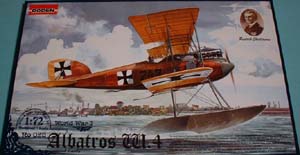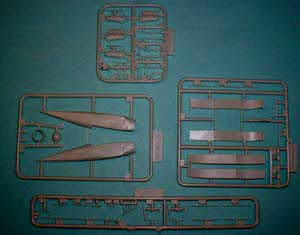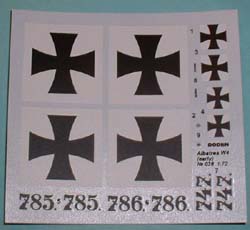| Roden 1/72nd Albatros W.4 (Early) |  | History In 1916, the German high command placed an order with several companies for the creation of a fighter with floats. Its primary use was to be defense of the coast of Flanders. Albatros quickly took its D.I and redesigned it to meet this need. While the fuselage remained the same, the wing area – as well as the gap between the wings – increased. The tail changed as did the fuselage underside to accept the floats. The first three off the assembly line – which could probably be considered prototypes – had the small floats of the early W.4. This led to a number of pilot complaints, resulting in the redesign of the floats. These later, longer floats were added to the rest of the production run. (Note that Roden has announced a W.4 (Late) which probably includes the later floats.) The Kit The Roden W.4 (Early) is molded up to Roden's usual standards – with a couple of caveats. The kit comes with 58 parts on the sprue, of which 12 aren't used for the Early version. Decals are for the first three off the assembly line – 747, 785 and 786. Decals consist of crosses for the wings, fuselage and rudder, as well as the above mentioned numerals and the Axial logos for the props and a couple of small decals meant – it looks like – for the datum panels.  The molding caveats are as follows. First the Early, upper wing has molding flaws at the tips – nothing that a bit of careful sanding won't eliminate. Another molding flaw is on only one of the upper wing pieces (the upper wing being in three separate parts) neat the aileron actuator. There is a bulge of plastic that also needs careful removal – more care needed than the tips because of the surrounding detail. Again, not a big deal that is within the capabilities of most modelers. The last, more serious flaw exists on each of the Windhoff radiators. There is a sinkhole in the face of each radiator, something difficult to eliminate without removing too much detail. The molding caveats are as follows. First the Early, upper wing has molding flaws at the tips – nothing that a bit of careful sanding won't eliminate. Another molding flaw is on only one of the upper wing pieces (the upper wing being in three separate parts) neat the aileron actuator. There is a bulge of plastic that also needs careful removal – more care needed than the tips because of the surrounding detail. Again, not a big deal that is within the capabilities of most modelers. The last, more serious flaw exists on each of the Windhoff radiators. There is a sinkhole in the face of each radiator, something difficult to eliminate without removing too much detail. Construction stars with the eight pieces of the engine, paying attention to the instructions telling you what to remove for this version of the W.4. From there construction moves to parts of the cockpit, to adding these and other parts – as well as the engine ñ into one fuselage half and assembling the fuselage halves. Again, the instructions need to be followed closely as they tell you which external details need to be removed from the fuselage halves for this version.  Once the fuselage halves are assembled, then construction moves to adding the tail, lower wings and the forward, upper part of the fuselage. In all reviews I have read on Roden's Albatros', dry fitting is a must when adding the forward, upper fuselage to achieve a close-to-perfect fit. In addition part of the nose, behind the spinner, is added at this time. Once the fuselage halves are assembled, then construction moves to adding the tail, lower wings and the forward, upper part of the fuselage. In all reviews I have read on Roden's Albatros', dry fitting is a must when adding the forward, upper fuselage to achieve a close-to-perfect fit. In addition part of the nose, behind the spinner, is added at this time. Now the floats are glued together. Care must be taken when removing the upper parts of the floats as the struts that connect the two floats together horizontally are molded integral with the upper float pieces. The last part of major construction – before putting all the pieces together to make up a complete airframe – is the gluing together of the three, upper wing parts. Again, care and dry fitting are the norm to achieve a close-to-perfect fit. Since all of the major parts of the plane are now together, construction moves to adding the upper wing, floats and all struts associate with both. However, before doing so I recommend painting each part individually first.  These first three airframes were delivered 'natural', meaning the flying surfaces were linen while the wood fuselage and floats were also left natural wood. The most difficult aspect to finishing this model is deciding on which decal numbers to add to the sides of the fuselage. These first three airframes were delivered 'natural', meaning the flying surfaces were linen while the wood fuselage and floats were also left natural wood. The most difficult aspect to finishing this model is deciding on which decal numbers to add to the sides of the fuselage. Conclusion This is another, decent Roden Albatros. Unfortunately there exist the flaws mentioned above, but most are well within the realms of most modelers. With much care and patience a very handsome floatplane will be the result. Our thanks to Roden and Squadron for the review kits. | 







|

 The molding caveats are as follows. First the Early, upper wing has molding flaws at the tips – nothing that a bit of careful sanding won't eliminate. Another molding flaw is on only one of the upper wing pieces (the upper wing being in three separate parts) neat the aileron actuator. There is a bulge of plastic that also needs careful removal – more care needed than the tips because of the surrounding detail. Again, not a big deal that is within the capabilities of most modelers. The last, more serious flaw exists on each of the Windhoff radiators. There is a sinkhole in the face of each radiator, something difficult to eliminate without removing too much detail.
The molding caveats are as follows. First the Early, upper wing has molding flaws at the tips – nothing that a bit of careful sanding won't eliminate. Another molding flaw is on only one of the upper wing pieces (the upper wing being in three separate parts) neat the aileron actuator. There is a bulge of plastic that also needs careful removal – more care needed than the tips because of the surrounding detail. Again, not a big deal that is within the capabilities of most modelers. The last, more serious flaw exists on each of the Windhoff radiators. There is a sinkhole in the face of each radiator, something difficult to eliminate without removing too much detail. Once the fuselage halves are assembled, then construction moves to adding the tail, lower wings and the forward, upper part of the fuselage. In all reviews I have read on Roden's Albatros', dry fitting is a must when adding the forward, upper fuselage to achieve a close-to-perfect fit. In addition part of the nose, behind the spinner, is added at this time.
Once the fuselage halves are assembled, then construction moves to adding the tail, lower wings and the forward, upper part of the fuselage. In all reviews I have read on Roden's Albatros', dry fitting is a must when adding the forward, upper fuselage to achieve a close-to-perfect fit. In addition part of the nose, behind the spinner, is added at this time. These first three airframes were delivered 'natural', meaning the flying surfaces were linen while the wood fuselage and floats were also left natural wood. The most difficult aspect to finishing this model is deciding on which decal numbers to add to the sides of the fuselage.
These first three airframes were delivered 'natural', meaning the flying surfaces were linen while the wood fuselage and floats were also left natural wood. The most difficult aspect to finishing this model is deciding on which decal numbers to add to the sides of the fuselage. 






